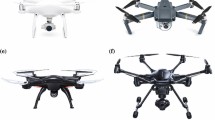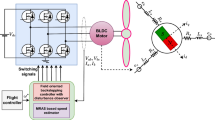Abstract
In this paper, an error-driven adaptive feedback control with an extended state observer (ANCESO) has been developed for the three-axis electrical-optical gyro-stabilized platform. The proposed controller takes into account not only the system parametric deviations as well as external disturbances via integrating adaptive nonlinear feedback tracking control and the extended state observer design. An improved error-driven nonlinear functions are constructed with feedback gain self-regulates to avoid the high gain chattering of the closed loop system. By integrating the fundamentally different working mechanisms of the approaches, the developed ANCESO strategy is able to preserve the theoretical performance results of both design approaches while overcoming their practical performance limitations. Comparative experimental results are obtained to validate the benefits and effectiveness of the proposed control strategy.
Similar content being viewed by others
References
S. I. Han and J. M. Lee, “Adaptive dynamic surface control with sliding mode control and RWNN for robust positioning of a linear motion stage,” Mechatronics, vol. 22, no. 2, pp. 222–238, March 2012.
H. Q. Wang, X. P. Liu, and K. F. Liu, “Adaptive neural data-based compensation control of non-linear systems with dynamic uncertainties and input saturation,” IET Control Theory & Applications, vol. 9, no. 7, pp. 1058–1065, May 2015.
J. Wu, J. Li, and W. S. Chen, “Semi-globally/globally stable adaptive NN backstepping control for uncertain MIMO systems with tracking accuracy known a priori,” Journal of the Franklin Institute. vol. 351, no. 12, pp. 5274–5309, August 2014.
L. Lu, B. Yao, Q. Q. Wang, and Z. Chen, “Adaptive robust control of linear motors with dynamic friction compensation using modified LuGre model,” Automatica, vol. 45, no. 12, pp. 2890–2896, December 2009.
J. C. Fang, R. Yin, and X. S. Lei, “An adaptive decoupling control for three-axis gyro stabilized platform based on neural networks,” Mechatronics, vol. 27, pp. 38–46, April 2015.
Y. F. Wu and D. Yue, “Robust adaptive neural network control for a class of multiple-input multiple-output nonlinear time delay system with hysteresis inputs and dynamic uncertainties,” Asian Journal of Control, vol. 21, no. 5, pp. 2330–2339, September 2019.
A. Mohanty and B. Yao, “Indirect adaptive robust control of hydraulic manipulators with accurate parameter estimates,” IEEE Transactions on Control Systems Technology, vol. 19, no. 3, pp. 567–575, May 2011.
J. Zhao, J. Wang, and S. Wang, “Fractional order control to the electro-hydraulic system in insulator fatigue test device,” Mechatronics, vol. 23, no. 7, pp. 828–839, October 2013.
Y. K. Ma and H. B. Ji, “Robust control for spacecraft rendezvous with disturbances and input saturation,” International Journal of Control, Automation, and Systems, vol. 13, no. 2, pp. 353–360, February 2015.
Z. Zhou, B. Wang, M. Dong, and K. Ota, “Secure and efficient vehicle-to-grid energy trading in cyber physical systems: Integration of blockchain and edge computing,” IEEE Transactions on Systems, Man, and Cybernetics: Systems, vol. 50, no. 1, pp. 43–57, January 2020.
Y. Sun, J. Xu, G. Lin, W. Ji, and L. Wang, “RBF neural network-based supervisor control for maglev vehicles on an elastic track with network time-delay,” IEEE Transactions on Industrial Informatics, vol. 18, no. 1, pp. 509–519, 2022.
Y. Sun, J. Xu, H. Wu, G. Lin, and S. Mumtaz, “Deep learning based semi-supervised control for vertical security of maglev vehicle with guaranteed bounded airgap,” IEEE Transactions on Intelligent Transportation Systems, vol. 22, no. 7, pp. 4431–4442, 2021.
J. Han, “From PID to active disturbance rejection control,” IEEE Transactions on Industrial Electronics, vol. 56, no. 3, pp. 900–906, March 2009.
W. Xue, W. Bai, S. Yang, K. Song, Y. Huang, and H. Xie, “ADRC with adaptive extended state observer and its application to air-fuel ratio control in gasoline engines,” IEEE Transactions on Industrial Electronics, vol. 62, no. 9, pp 5847–5857, September 2015.
P. M. Patre, W. MacKunis, M. Johnson, and W. E. Dizon, “Composite adaptive control for Euler-Lagrange systems with additive disturbances,” Automatica, vol. 46, no. 1, pp. 140–147, January 2010.
L. Wang, G. Gong, H. Yang, X. Yang, and D. Hou, “The development of a high-speed segment erecting system for shield tunneling machine,” IEEE/ASME Transactions on Mechatronics, vol. 18, no. 6, pp. 1713–1723, December 2013.
W. Sun, S. F. Su, Y. Wu, J. Xia, and V. T. Nguyen, “Adaptive fuzzy control with high-order barrier Lyapunov functions for high-order uncertain nonlinear systems with fullstate constraints,” IEEE Transactions on Cybernetics, vol. 50, no. 8, pp. 3424–3432, August 2020.
D. Swaroop, J. K. Hedrick, P. P. Yip, and J. C. Gerdes, “Dynamic surface control for a class of nonlinear systems,” IEEE Transactions on Automatic Control, vol. 45, no. 10, pp. 1893–1899, October 2000.
Y. Tang, Y. Wu, M. Wu, X. Hu, and L. Shen, “Nonlinear tracking differentiator for velocity determination using carrier phase measurements,” IEEE Journal of Selected Topics in Signal Processing, vol. 3, no. 4, pp. 716–725, August 2009.
Y. Hou and S. Tong, “Command filter-based adaptive fuzzy backstepping control for a class of switched nonlinear systems,” Fuzzy Sets and Systems, vol. 314, no. 1, pp. 46–60, May 2017.
G. Q. Song, S. M. Sun, and J. Guang, “Adaptive dynamic surface control for spacecraft terminal safe approach with input saturation based on tracking differentiator,” International Journal of Control, Automation, and Systems, vol. 16, no. 3, pp. 1129–1141, May 2018.
H. Wang, H. R. Karimi, H. K. Lam, and H. Shen, “An improved result on exponential stabilization of sampled-data fuzzy systems,” IEEE Transactions on Fuzzy Systems, vol. 26, no. 6, pp. 3875–3883, December 2018.
J. Li, X. Chen, F. Hao, and J. Xie, “Event-triggered bipartite consensus for multi-agent systems with antagonistic interactions,” International Journal of Control, Automation, and Systems, vol. 17, no. 8, pp. 2046–2058, July 2019.
H. R. Dong, S. R. Gao, B. Ning, T. Tang, Y. Li, and K. P. Valavanis, “Error-driven nonlinear feedback design for fuzzy adaptive dynamic surface control of nonlinear systems with prescribed tracking performance,” IEEE Transactions on Fuzzy Systems, vol. 26, no. 6, pp. 3875–3883, December 2018.
Author information
Authors and Affiliations
Corresponding author
Additional information
This work was supported in part by the National Natural Science Foundation of China under Grant 11902162 and 51705264, in part by the Research Fund for the China Postdoctoral Science Foundation under Grant 2018M642295 and 2020M681680, in part by the Natural Science Foundation of Jiangsu Higher Education Institutions of China 19KJB510051, and in part by the Metasequoia teacher research start-up project 163040148.
Yang Yang was born in Tai Yuan, Shanxi Province, China. He received his M.E. degree from the Nanjing University of Aeronautics and Astronautics, Nanjing, China, in 2020. He is now pursuing a Ph.D. degree in the School of Remote Sensing and Information Engineering,Wuhan University, Wuhan, China. His research interests include analysis and synthesis of networked control systems, multi-agent systems, optimal control of power systems, and internet of things.
Yuefei Wu was born in Xiao Gan, Hubei Province, China. He received his B.E., M.E., and Ph.D. degrees in weapons launch technology and theory from Nanjing University of Science and Technology, China, in 2006, 2010, and 2015, respectively. He is with the College of Automation, Nanjing University of Posts and Tele-communications. His research study on the control methods of nonlinear electromechanical position servo system with uncertainties.
Fengbo Yang was born in Jing Men, Hubei Province, China. He received his Ph.D. degree in weapons launch technology and theory from Nanjing University of Science and Technology, China, in 2015. He is with the College of Mechanical and Electronic Engineering, Nanjing Forestry University. His research study on the precision spraying control technology and multiphase fluid dynamics.
Publisher’s Note
Springer Nature remains neutral with regard to jurisdictional claims in published maps and institutional affiliations.
Rights and permissions
About this article
Cite this article
Yang, Y., Wu, Y. & Yang, F. Extended-state-observer-based Error-driven Adaptive Nonlinear Feedback Control of Electrical-optical Gyro-stabilized Platform via Modified Dynamic Surface Control with Error Constraint. Int. J. Control Autom. Syst. 20, 1961–1970 (2022). https://doi.org/10.1007/s12555-021-0175-0
Received:
Revised:
Accepted:
Published:
Issue Date:
DOI: https://doi.org/10.1007/s12555-021-0175-0




